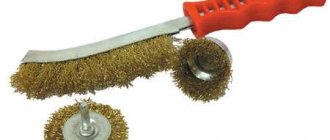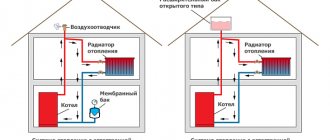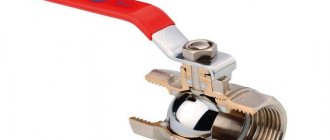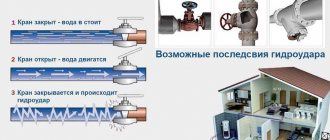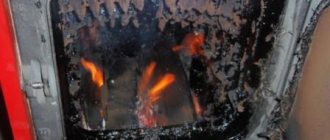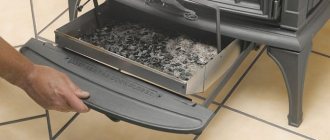A variety of ways to seal a fistula
To properly deal with the problem, first of all, you need to understand what a fistula in a pipeline is. This is the hole in the pipe through which water flows out.
You can eliminate it in several ways:
- using a bolt;
- using a temporary bandage;
- using an adhesive bandage;
- cold welding method.
But at the same time, it is imperative to drain the water from the system by closing the valves and opening all available taps.
Plastic pipe repair
The formation of defects on plastic highways is quite rare. To eliminate a leak, use the following methods:
- The fitting from which a trickle of water flows out is simply tightened. For reliability, add sealant. Do not use excessive force, as the plastic may crack. The soldered polypropylene coupling is reinstalled.
- If the fistula in the pipe appears in a straight section, it is cut out and then replaced. PVC inserts are secured with fittings, polypropylene inserts are secured by welding.
The considered methods for eliminating leaks eliminate the problem for a short time. After repair, the fistula may continue to grow or a new one will appear in the neighborhood. Therefore, you should not postpone replacing the damaged area indefinitely.
Repair using a temporary bandage
This method is used when the fistula in the pipeline has an oblong, elongated appearance.
A bandage is applied to the hole using sealing gaskets, which can be made from the following products:
- medical tourniquet;
- thick glove;
- bicycle tire;
- boot top, etc.
The main thing is that the size of the rubber gasket is significantly larger than the size of the hole. To fix the bandage on the pipeline, clamps or bolts are used.
How to weld a fistula in a plastic pipe with water
Unlike the previous option, which could be used not only for plastic products, this method is suitable for working with polypropylene pipe products.
The actions are carried out using a special tool for soldering plastic - an iron. This tool melts the prepared components and fastens them after cooling.
To repair minor damage to an area, all repair measures can be carried out under pressure.
But, for a formation of significant size, the water supply system will have to be shut off, since it will be impossible to weld the defect under pressure.
Anyone can operate an iron. No special experience is required for this. Such devices come with instructions that describe the entire operating process step by step.
After reading it carefully, you can safely begin repairing the PP pipeline. It is not difficult to seal a leak this way.
Sealing with adhesive bandage
Elimination of a fistula using this method is carried out in stages:
- Use a metal brush to clean the pipeline from dirt, treat its surface with acetone or gasoline and allow it to dry for 15 minutes.
- Tapes are cut from fiberglass, the length of which depends on the diameter of the pipe - it is necessary that the winding has at least 6 layers. The width of the material must exceed the cross-section of the pipeline by no less than one third.
- BF-2 glue is applied to the edges of the tape, then one side of it is covered with an epoxy adhesive with a spatula.
- The tool is pressed firmly against the fiberglass so that it is well saturated with glue.
- Then the tape is tightly wound onto a previously prepared surface so that its center covers the problem area.
- The bandage is secured with metal tape.
- After 24 hours, the repaired pipeline can be used.
If the system is laid in an unheated room where the temperature does not exceed 17 degrees, the pipeline can be used only after 4 days.
What to do
If the water is in full swing, it is recommended to change the system or part of it immediately ; all attempts to solve the problem by other methods can only be temporary.
If the trickle is small, the leak can be eliminated by sealing the hole after turning off the water supply. After draining the system, it is easier to determine the size of the hole. To do this, clean the leak area with sandpaper, removing a layer of paint and rust.
Before you begin to fix the problem, you need to degrease the surface with acetone or gasoline.
Note! Cleaning and degreasing is an important stage of repair; if you neglect this and try to seal the hole on an untreated, uneven surface, it will be difficult to achieve maximum tightness, and after a while the problem will make itself felt again.
By cleaning and degreasing the surface, you can assess the nature of the hole and its size, and choose the most correct repair method.
We recommend that you read: Review of fittings for installing copper pipes
Options for eliminating a fistula in a metal pipe
| Way | Description | Peculiarities |
| Rubber pads | A strip of rubber with a length greater than the diameter of the pipe by 50 mm and less than the circumference of the clamp by approximately 100 mm is wrapped around the pipe at the site of damage. The bandage is tightly fixed with a clamp. | A universal method that is suitable for repairing various types of leaks in pipelines for various purposes. If the hole is small, you don’t even have to interrupt the water supply. |
| Adhesive bandage | A medical bandage or fiberglass soaked in an adhesive solution is wrapped in the form of a cocoon around the pipe at the leak site six times, covered with a layer of epoxy glue on top, and secured with a clamp. | The water supply can be turned on again only a day after it has completely dried. Instead of glue, you can use a cement solution. |
| With a bolt | Expand the hole using a drill, cut a thread in it, then screw in a self-tapping screw or screw. | Suitable for repairing minor damage. It is not recommended for use on old pipes, where such actions may further damage the pipe. |
| Cold welding | Apply the product to the damaged area. | It is considered a temporary measure, after which another better and more reliable method of repairing fistulas should be used. It should be remembered that cold welding is quickly destroyed under the influence of hot water and high temperature. |
| Bandage and table salt | Small defects at the joints can be eliminated using a bandage sprinkled with salt, which, when dissolved in water, closes microcracks. | Not suitable for repairing large holes. |
Options for eliminating leaks in plastic pipes
Fistulas on plastic pipes can be eliminated by welding or threading:
| Welding | Cut the damaged piece of pipe, prepare the fitting and workpiece. Using a plastic soldering iron, melt the ends of the fitting and pipe and connect the melted ends. You should work quickly, remembering that the plastic hardens quite quickly, so it won’t be possible to redo it; you need accuracy and precision in your actions and work skill. |
| Threaded method | Prepare an insert of the required size, cut a thread using a tape measure on a plastic pipe, then fasten the structure using a coupling. |
Cold welding method
Repair of water pipes without welding is carried out using a special composition:
- The hole is expanded with a drill.
- The surface of the pipeline is degreased and cleaned with acetone.
- When the pipe is dry, a product called “cold welding” is applied to it and wait until it hardens completely - this usually takes about 10 minutes.
When using cold welding or epoxy adhesive, you must use rubber gloves. If glue gets on the skin, it must be removed with cotton wool and acetone, and then washed with warm water and soap.
Flowing in the middle of the pipe
You need to inspect everything and identify the location of the damage. What to do if the hole is small and water is flowing, but there is no way to call a plumber? You can use Titanium White automotive putty and fill the hole with it.
This repair method will extend the life of the pipe by several years, but only if it does not supply water under high pressure.
If the leak is significant, then a layer of rubber, the so-called bandage, is placed in place of the gap, which should be larger in size than the hole.
The patch is fixed using soft wire. All of the above items can be purchased at a hardware store.
Do not forget that this method can be repaired only for a temporary effect (until the arrival of a master who can properly fix everything).
Unreliable connecting seam
What to do if water flows at the junction of the pipe to the battery, tap or in the area of the threaded joint? In this case, eliminating the problem will be somewhat more complicated, since sometimes elements of different diameters are connected.
Find out all the reasons why a kitchen faucet may drip and how to eliminate these defects.
What to do in this case? You can seal the hole using a piece of thin rubber, which must be clamped with a special metal clamp.
This solution cannot be a 100% solution to the problem. The joint will have to be disassembled and thoroughly welded or glued.
Final repairs can only be made if the heating and water drainage systems are completely turned off. If in a private house this process can be done independently, then in an apartment it is recommended to entrust such work to a specialist.
If the house has autonomous heating, the owner must always have new couplings and spare connecting elements on hand so that in the event of an accident, the hole can be quickly repaired.
Leaking between battery sections - what to do?
A small hole from which water flows can be sealed using a regular self-tapping screw, which can be found in every home.
Naturally, such a solution will not be enough for a long time, but it will still help eliminate the damage that even a slight leak can cause.
Is the radiator leaking? No problem!!! Radiator sealant.
Second way. It is recommended to wrap the problem area with a thick cloth soaked in sealant or an adhesive solution that is resistant to water (hypoxide glue).
When the fabric is dry, you can connect the battery to the system, but in order to seal it properly, you should still seek help from a plumber.
What to do if the cause of the accident was a surge in water pressure? First of all, you should take care of eliminating the internal problem.
The use of pipes of different cross-sectional sizes may result in water hammer, especially in the process of eliminating air pockets.
In what cases is heating system repair necessary?
In any case, major repairs of heating systems are carried out on warm spring or summer days before the start of the winter season.
If there have been iron pipes in the apartment for more than five years, you need to think about replacing them with reinforced polypropylene samples, without waiting for it to burst.
The latter do not undergo oxidation when interacting with water and withstand water hammer, which makes them more durable compared to iron ones.
Repairing a heating battery without releasing water from the system. Do it yourself. Personal experience.
Often, when repairing heating system pipes, professionals recommend sealing holes with “cold welding”. This material is super durable and, after drying, reliably covers any leaks.
All of the above methods for repairing heating pipes are not bad, but they can only save for a while, so in order not to ask yourself the following question: “The heating pipe is leaking, what should I do?” – call a plumber who can correctly and reliably fix all problems associated with the operation of the heating system, so that later, when winter comes, you do not have to carry out expensive repairs and do not turn off the entire house from heating.
Features of hot water supply
A fistula in a hot water pipe appears more often than in other places. The place that is most susceptible to this phenomenon is the riser. The first signs of danger in such a system are rusty growths.
Video: how to fix a leak on the drain
Elimination of leaks on the eviction
It was already written above that if a decision is made to seal a leak, then this build-up cannot be torn off. In the case of hot water, such actions can cause serious burns.
Such a fistula in the pipeline can be repaired using a bolt or temporary bandage. In both the first and second cases, it is impossible to act under pressure. The water supply must be shut off before work can be done.
A small leak can be sealed under pressure using an adhesive bandage. The edges of fiberglass with BF-2 glue applied are applied to the damaged area (the tape is applied very tightly). At the end, the tape must be tightened with a metal plate. Such a section will be able to function under pressure only after 24 hours.
Also in this situation, you can seal the leak with “cold welding”. It is better not to do such work under pressure. The resulting hole is slightly enlarged using a drill, and the area is degreased.
When everything is dry, apply the compound to the leaking crack. It should freeze completely. This takes approximately ten minutes.
Consequences of clogging
Regardless of the source of the blockage in the heating pipe, the outcome is almost always the same:
- after a certain point the pipes become clogged;
- the movement of water in the pipes decreases and later even the water pump will not be able to pump water through this system.
The situation is much worse with thermosyphon heating, where there is no such pump. As a rule, once clogged, heat is not allowed to pass through and the pipes remain cold. And this is only part of the problem. In addition, the boiler itself begins to heat up very much, which can lead to its breakdown.
Some owners carry out annual cleaning of blockages in such a system by changing the water. In other words, the old unclean, rusty water is drained and filled with new water. And this is reasonable, because when the old water is drained, a small amount of chips and rust leaves it. But there is also the opposite side. For rust to occur, iron and oxygen are required. If the pipe is metal, then there is always iron in it, but oxygen is contained in the water. As a rule, when you do not change the fluid in the heating system for a long time, the oxygen content in it decreases significantly, which means that the rusting process stops. With a constant change of water, on the contrary, it is activated. To summarize, we can say one thing - this method helps to get rid of a small amount of rust, but, on the other hand, we only accelerate the new process of its formation.
Leaks in various systems
A fistula in a hot water pipe or any other system that consists of metal pipes can be quickly repaired in the following ways:
Option 1.
Medical bandage and cement solution. It is cut into pieces and soaked in pre-prepared cement mortar. These bandages are wrapped around the leakage area, forming a cocoon-like structure.
Finally, the resulting structure is also covered with cement mortar. It dries in about one day.
Option 2.
Pieces of rubber. Rubber is cut into strips. Each of them should be slightly longer than the circumference of the pipe.
Option 3.
Table salt and bandage. As a rule, this method is used to seal pressure leaks in couplings, elbows, etc. The leaking area is wrapped in a bandage mixed with salt.
When dissolved, salt fixes micro-leakage. If we compare this method of sealing under pressure, it is immediately worth noting that it is not as reliable as the first two.
Option 4.
Bandage. This method can be used for pressure pipes. The bandage is considered one of the oldest and most proven options. A small car clamp can be used for a fistula with a volume of up to 0.005 cm.
For the clamp, a strip of rubber is cut out, a couple of millimeters wider than the clamp itself. The length of the strip should be one centimeter shorter than the circumference of the pipeline. .
This entire structure must completely cover the fistula. Next, the clamp is tightened. During these activities, the surface at the site of corrosion must be cleaned.
Video: ways to repair a fistula
It should not contain any irregularities. If this is not done, the liquid will pass through the bandage in the area of uneven areas.
Causes of fistulas
The reasons for the formation of fistulas on a water pipe most often come down to one denominator. This is the effect of corrosion.
The most suitable temperature indicator for corrosive formations is +15 degrees. Most often, pipe rolling materials are in this mode in the spring, summer and autumn periods.
Water located in the system also accelerates corrosive destruction. Over time, rust builds up inside metal pipelines.
Repairing leaks near fittings
As a rule, leaks in metal-plastic pipes appear due to problems with connecting devices, namely fittings. To eliminate water leakage, sometimes it is enough to tighten the nut more tightly, since compression fittings tend to weaken the strength of the connection over time (frequency - once every 2-3 years).
The nuts need to be tightened periodically
If after this water continues to leak, you need to perform a thorough inspection of the system. To do this, drain the water from the pipeline and proceed according to the instructions:
- check the rubber sealing ring inserted between the fitting and the fitting body for damage;
- assess the degree of wear of the rubber gaskets on the fitting;
- inspect how smooth the pipe cut is.
Layout of the ferrule ring in the fitting
After fixing the problem, reassemble the pipeline, treating the joints with silicone grease and wrapping the threads with sealing material (for example, FUM tape).
Eliminating leaks in pipelines installed using press fittings
When using brass press fittings to assemble metal-plastic pipelines, an adjustable wrench is required. Installation of this connection involves tightening the nuts with slight force to a certain point.
Sometimes the nuts are tightened too tightly, which leads to the formation of defects in the soft ring located inside the press fitting, and, as a result, leaks.
If this is exactly what happened to you, repairing metal-plastic pipes with your own hands is done as follows:
Press fitting diagram
- dismantle the leaking connection: unscrew the cap nut, remove the end of the pipe from the fitting;
- remove the old soft ring from the fitting using a hacksaw, sand the pipe cut with a fine-grained sanding mesh (you can use a regular wire sponge), put the new ring on the pipe;
- reassemble the connection; tighten the cap nut located on the body of the connecting device with a wrench, making one full turn;
- check the waterproofing of the joint - if the leak is not eliminated, tighten the nut another 1/4 turn with a wrench.
Causes and types of problems
The metal-plastic pipe is made of aluminum and protected by several layers of polyethylene inside and out, welds are made with a laser. This structure guarantees the strength of the product and resistance to corrosion. Therefore, if your metal-plastic pipes are leaking, this may be due to the following problems:
- When laying pipes, the installation technology was violated (for example, the bending radius was exceeded);
- during operation, a serious mechanical impact occurred, resulting in a violation of the integrity of the pipes;
- water leaks from poorly executed joints.
Most common leak location
Possible failure of the pipeline can be prevented even at the time of its installation. When laying metal-plastic pipes, bends are made using springs specially designed for this purpose. The maximum bending angle is 45, otherwise the pipe may burst during operation.
Fighting rust
To prevent rust from ruining the heating, you need to prepare the system for startup in advance. For this purpose, you need not just pour water into the pipe, but add special antifreeze to it. Its effect is the same as in engine fluid, that is, it guarantees good heat transfer through the pipes, and also forms protection for metal surfaces from oxidative processes and prevents the occurrence of lime deposits and other deposits. This alternative is quite expensive, but it makes it possible to forget about constant cleaning.
The entire cleaning stage is relatively simple and does not require the use of complex techniques. The process will proceed as follows:
- pipe cleaning;
- cleaning the heating boiler itself.
Pipe cleaning
The easiest method of cleaning a heating system is to use chemicals. All we need is to buy a product that can dissolve rust and other types of deposits.
A similar remedy can be ordinary citric acid, which every housewife has. It must be dissolved in water, it is advisable to use a three-liter jar, since a large amount gives a greater effect. This entire solution must be poured into the heating system. Subsequently, you immediately need to light the boiler, set the temperature to a high level, and wait twenty-four hours. Later we drain this water. We flush the pipes by filling and re-draining clean water.
Another similar technique is the use of food vinegar. To achieve the best effect, you need a lot of it. But there is also a more win-win option - using hydrochloric acid, preferably 10 or 20%. This chemical is excellent at cleaning pipes. But you need to be careful with this substance, since too high a concentration can significantly damage the heating system.
This operation is only suitable for small blockages. If the pipes are thoroughly clogged, then a compressor will help out. Most often, this method is called hydropneumatic cleaning.
The process will proceed as follows:
- connect the compressor to the heating system;
- connect the compressor to the pipe and start it up;
- flushing begins by simultaneous combination with pneumatic shocks;
- disconnect the pipe going into the boiler (from below);
- We place some container near it so that dirty water flows into it;
- Clean water must constantly flow into the riser (while draining unclean water).
The compressor is expensive and if you don’t want to spend money, you can dismantle the radiators (each separately). That is, they are washed under enormous water pressure.
Boiler cleaning
There may also be deposits in the boiler itself. In addition, there are more of them here than in pipes. The fact is that it heats up very much, which speeds up the process.
Chemicals are used here. The whole job is quite simple: you need to disconnect the heating pipes, take a pump, which is combined with the boiler and water is let in through it, with chemicals added in advance. We drain all dirty water and then rinse with clean water.
Having mastered all the tips discussed, you will be able to flush the heating system yourself with complete confidence.
